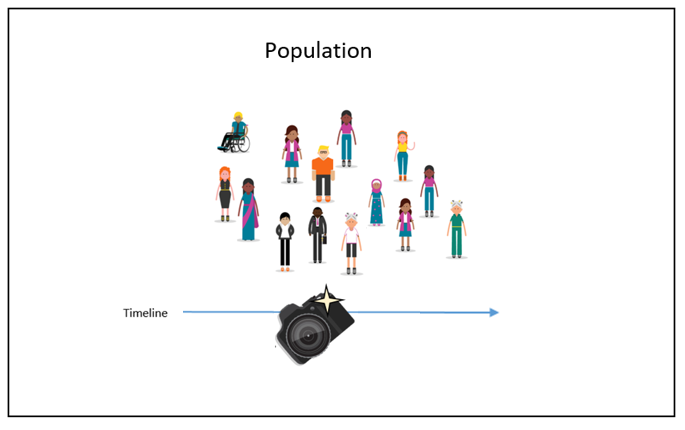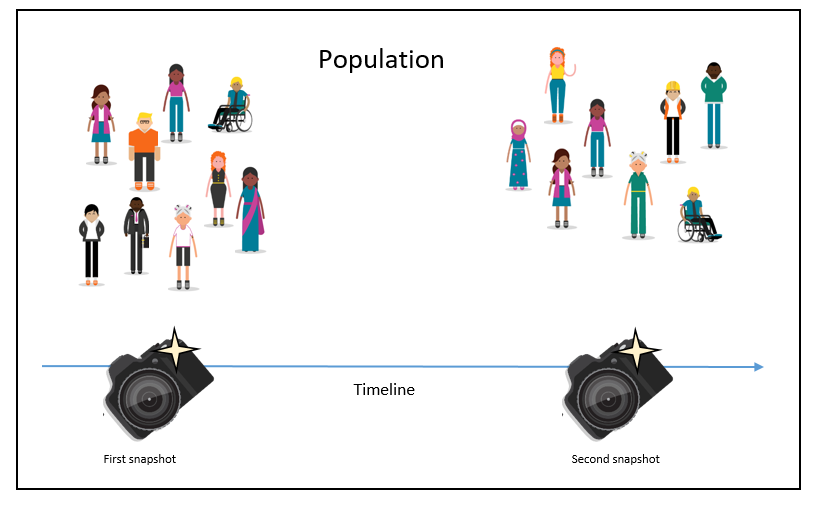Cross-Sectional Study
The Australian Census run by the Australian Bureau of Statistics, is an example of a whole of population cross-sectional study.
Data on a number of aspects of the Australian population is gathered through completion of a survey within every Australian household on the same night. This provides a snapshot of the Australian population at that instance.
Cross-sectional studies look at a population at a single point in time, like taking a slice or cross-section of a group, and variables are recorded for each participant.
This may be a single snapshot for one point in time or may look at a situation at one point in time and then follow it up with another or multiple snapshots at later points; this is then termed a repeated cross-sectional data analysis.
The stages of a Cross-Sectional study
Cross-Sectional Study

Repeated Cross-Sectional Data Analysis

Which clinical questions does a Cross-Sectional study best answer?
Please note the Introduction, where there is a table under "Which study type will answer my clinical question?". You may find that there are only one or two question types that your study answers – that’s ok.
Cross-sectional study designs are useful when:
- Answering questions about the incidence or prevalence of a condition, belief or situation.
- Establishing what the norm is for a specific demographic at a specific time. For example: what is the most common or normal age for students completing secondary education in Victoria?
- Justifying further research on a topic. Cross-sectional studies can infer a relationship or correlation but are not always sufficient to determine a direct cause. As a result, these studies often pave the way for other investigations.
| Question Type | Study Example | |
|---|---|---|
| Frequency | How common is the outcome (disease, risk factor, etc.)? | This cross-sectional study is of the common mental disorders among Indigenous people living in regional, remote and metropolitan Australia. |
| Aetiology | What risk factors are associated with these outcomes? | This cross-sectional study identifies the characteristics of women calling the perinatal anxiety & depression Australia (PANDA) national helpline. |
| Diagnosis | Does the new test perform as well as the ‘gold standard’? | This cross-sectional study investigates the accuracy of a Client Satisfaction Questionnaire in relation to client satisfaction in mental health service support. |
Advantages and disadvantages to a Cross-Sectional study
Below are some advantages and disadvantages to consider when using a Cross-Sectional study.
Advantages
- If appropriate for the research question, a cross-sectional study can be an efficient and fast study design option. When conducting repeated analysis a cross-sectional study design is not necessarily measuring the exact same participants in both instances. Rather a representation of that same population. This means there isn’t a problem if the first sample of participants no longer wish to comply with the study. And when measuring the attributes of different age groups, a cross-sectional study does not need to wait for the participants to age with time the way that a longitudinal study does.
- Cross-sectional studies may still use some experimental approaches such as physically observing participants. However when appropriate, cross-sectional study designs can work just as effectively using less labor intensive data collection methods. This may include using survey collection, use of archival data, and questionnaires. Using the above collection methods online or via phone can also mean that a broader population can be reached.
- Using a cross-sectional design, multiple variables can be investigated at the one time. For example, cross-sectional studies can collect data on a range of attributes in the one instance; the gender, age, health conditions, access to services, etc.
- Observational cross-sectional studies are often useful when looking for an ethical approach to investigate harmful situations that would otherwise be unethical if inflicted on a participant. The researcher is not imposing any conditions on the subjects of the study. Instead the results come from a population already experiencing or having previously experienced the situation.
Disadvantages
- Cross-sectional studies can identify potential correlations, associations and relationships between variables. However, often they cannot define direct causation. For example; a cross-sectional study comparing IQ scores of 20 year old women with those of 70 year old women cannot conclude that there will be a change across time for the 20 year old women. This is because the opportunities and experiences of each group prior to this measurement being taken are unique to their own generational experiences, e.g. educational opportunities. To measure this change a better approach would be a cohort study design or a longitudinal study design.
- Rare diseases and conditions can be hard to investigate using a cross-sectional study design. Finding a large enough number of participants that already have the variable of interest can sometimes be difficult.
What does a strong Cross-Sectional study look like?
- Appropriate recruitment of participants. The sample of participants must be an accurate representation of the population being measured.
- Sample size. As is the case for most study types a larger sample size gives greater power and is more ideal for a strong study design. Within a cross-sectional study a sample size of at least 60 participants is recommended, although this will depend on suitability to the research question and the variables being measured.
- A suitable number of variables. Cross-sectional studies ideally measure at least three variables in order to develop a well-rounded understanding of the potential relationships of the two key conditions being measured.
What are the pitfalls to look for?
Cross-sectional studies are at risk of participation bias, or low response rates from participants. If a large number of surveys are sent out and only a quarter are completed and returned then this becomes an issue as those who responded may not be a true representation of the overall population.
Critical appraisal tools
To assist with critically appraising cross-sectional studies there are some tools / checklists you can use.
- Axis Appraisal Tool for Cross Sectional Studies
- Critical Appraisal Tool for Cross- Sectional Studies (CAT-CSS)
- Critical appraisal tool for cross-sectional studies using biomarker data (BIOCROSS)
- CEBM Critical Appraisal of a Cross-Sectional Study (Survey)
- JBI Critical Appraisal checklist for analytical cross-sectional studies
- Specialist Unit for Review Evidence (SURE) 2018. Questions to assist with the critical appraisal of cross sectional studies
- STROBE Checklist for cross-sectional studies
Real World Examples
- The Australian National Survey of Mental Health and Wellbeing (NSMHWB)
A widely known example of cross-sectional study design, the Australian National Survey of Mental Health and Wellbeing (NSMHWB). This study was a national epidemiological survey of mental disorders investigating the questions: How many people meet DSM-IV and ICD-10 diagnostic criteria for the major mental disorders? How disabled are they by their mental disorders? And, how many have seen a health professional for their mental disorder?
Further resources
- Australian Government Department of Health. (2003). The Australian National Survey of Mental Health and Wellbeing (NSMHWB). 2019, from https://www.abs.gov.au/statistics/health/mental-health/national-survey-mental-health-and-wellbeing-summary-results/2007
- Bowers, D. a., Bewick, B., House, A., & Owens, D. (2013). Understanding clinical papers (Third edition. ed.): Wiley Blackwell.
- Gravetter, F. J. a., & Forzano, L.-A. B. (2012). Research methods for the behavioral sciences (Fourth edition. ed.): Wadsworth Cengage Learning.
- Greenhalgh, T. a. (2014). How to read a paper : the basics of evidence-based medicine (Fifth edition. ed.): John Wiley & Sons Inc.
- Hoffmann, T. a., Bennett, S. P., & Mar, C. D. (2017). Evidence-Based Practice Across the Health Professions (Third edition. ed.): Elsevier.
- Howitt, D., & Cramer, D. (2008). Introduction to research methods in psychology (Second edition. ed.): Prentice Hall.
- Kelly, P. J., Kyngdon, F., Ingram, I., Deane, F. P., Baker, A. L., & Osborne, B. A. (2018). The Client Satisfaction Questionnaire‐8: Psychometric properties in a cross‐sectional survey of people attending residential substance abuse treatment. Drug and Alcohol Review, 37(1), 79-86. doi: 10.1111/dar.12522
- Lawrence, D., Hancock, K. J., & Kisely, S. (2013). The gap in life expectancy from preventable physical illness in psychiatric patients in Western Australia: retrospective analysis of population based registers. BMJ: British Medical Journal, 346(7909), 13-13.
- Nasir, B. F., Toombs, M. R., Kondalsamy-Chennakesavan, S., Kisely, S., Gill, N. S., Black, E., Ranmuthugala, G., Ostini, R., Nicholson, G. C., Hayman, N., & Beccaria, G.. (2018). Common mental disorders among Indigenous people living in regional, remote and metropolitan Australia: A cross-sectional study. BMJ Open, 8(6). https://doi.org/10.1136/bmjopen-2017-020196
- Robson, C., & McCartan, K. (2016). Real world research (Fourth Edition. ed.): Wiley.
- Sedgwick, P. (2014). Cross sectional studies: advantages and disadvantages. BMJ : British Medical Journal, 348, g2276. doi: 10.1136/bmj.g2276
- Setia, M. S. (2016). Methodology Series Module 3: Cross-sectional Studies. Indian journal of dermatology, 61(3), 261-264. doi: 10.4103/0019-5154.182410
- Shafiei, T., Biggs, L. J., Small, R., McLachlan, H. L., & Forster, D. A. (2018). Characteristics of women calling the panda perinatal anxiety & depression australia national helpline: A cross-sectional study. Archives of Women's Mental Health. doi: 10.1007/s00737-018-0868-4
- Van Heyningen, T., Honikman, S., Myer, L., Onah, M. N., Field, S., & Tomlinson, M. (2017). Prevalence and predictors of anxiety disorders amongst low-income pregnant women in urban South Africa: a cross-sectional study. Archives of Women's Mental Health(6), 765. doi: 10.1007/s00737-017-0768-z
- Vogt, W. P. (2005). Dictionary of statistics & methodology : a nontechnical guide for the social sciences (Third edition. ed.): Sage Publications.